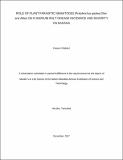Role of plant parasitic nematodes (pratylenchus goodeyi sher and allen) on fusarium wilt disease incidence and severity on banana
Abstract
A study to examine the status of Fusarium wilt disease (FWD) caused by Fusarium oxysporum f.sp. cubense (Foc) and plant parasitic nematode (PPN) (Pratylenchus goodeyi Sher and Allen) on banana was conducted in January to August 2017 at Meru District in Arusha and Rungwe District in Mbeya regions Tanzania. Forty eight farms, twelve villages in major banana growing areas were assessed for FWD incidence, severity and PPN damage using standard protocols. A pot culture experiment was also conducted to study the role of PPN on incidence and severity of FWD on banana in selected susceptible and resistant cultivars. The results indicated that highest (72%) FWD severity was at Sing’isi ward (Meru District) and the lowest (25.83%) was at Mpuguso ward (Rungwe District). The highest FWD incidence (11.48%) was at Nkoaranga ward followed by Akheri ward (8.95%) in Meru District and the lowest incidence (0.83%) was at Mpuguso ward in Rungwe District. The highest PPN damage (37.5%) was at Kimo ward in Rungwe District and the lowest (17.5%) was at Lufingo ward in Rungwe Disrtict. Such results indicated that FWD incidence and severity and PPN damage are a problem in the study area. The results for pot culture experiment revealed that, nematode inoculated 14 days prior to Foc and combined inoculation, showed higher FWD disease incidence and severity with a reduction in plant growth compared with untreated control. Such results suggest that PPN play a positive role in the incidence and severity of FWD on banana by acting as a predisposing factor for the fungal pathogen infestation causing injuries on the root surface as well as weakening the root tissues by causing root lesions.

